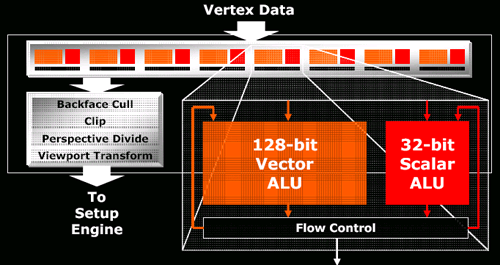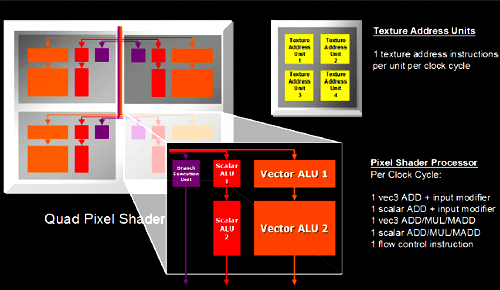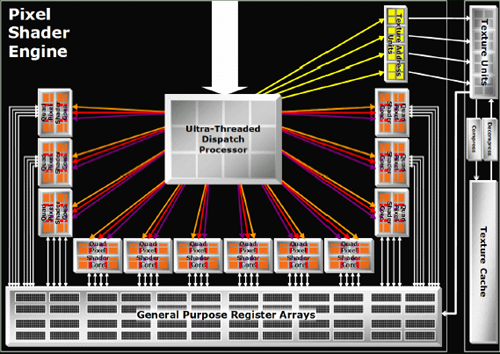ATI's New Leader in Graphics Performance: The Radeon X1900 Series
by Derek Wilson & Josh Venning on January 24, 2006 12:00 PM EST- Posted in
- GPUs
R580 Architecture
The architecture itself is not that different from the R520 series. There are a couple tweaks that found their way into the GPU, but these consist mainly of the same improvements made to the RV515 and RV530 over the R520 due to their longer lead time (the only reason all three parts arrived at nearly the same time was because of a bug that delayed the R520 by a few months). For a quick look at what's under the hood, here's the R520 and R580 vertex pipeline:

and the internals of each pixel quad:

The real feature of interest is the ability to load and filter 4 texture addresses from a single channel texture map. Textures which describe color generally have four components at every location in the texture, and normally the hardware will load an address from a texture map, split the 4 channels and filter them independently. In cases where single channel textures are used (ATI likes to use the example of a shadow map), the R520 will look up the appropriate address and will filter the single channel (letting the hardware's ability to filter 3 other components go to waste). In what ATI calls it's Fetch4 feature, the R580 is capable of loading 3 other adjacent single channel values from the texture and filtering these at the same time. This effectively loads 4 and filters four times the texture data when working with single channel formats. Traditional color textures, or textures describing vector fields (which make use of more than one channel per position in the texture) will not see any performance improvement, but for some soft shadowing algorithms performance increases could be significant.
That's really the big news in feature changes for this part. The actual meat of the R580 comes in something Tim Allen could get behind with a nice series of manly grunts: More power. More power in the form of a 384 million transistor 90nm chip that can push 12 quads (48 pixels) worth of data around at a blisteringly fast 650MHz. Why build something different when you can just triple the hardware?

To be fair, it's not a straight tripling of everything and it works out to look more like 4 X1600 parts than 3 X1800 parts. The proportions work out to match what we see in the current midrange part: all you need for efficient processing of current games is a three to one ratio of pixel pipelines to render backends or texture units. When the X1000 series initially launched, we did look at the X1800 as a part that had as much crammed into it as possible while the X1600 was a little more balanced. Focusing on pixel horsepower makes more efficient use of texture and render units when processing complex and interesting shader programs. If we see more math going on in a shader program than texture loads, we don't need enough hardware to load a texture every single clock cycle for every pixel when we can cue them up and aggregate requests in order to keep available resources busy more consistently. With texture loads required to hide latency (even going to local video memory isn't instantaneous yet), handling the situation is already handled.
Other than keeping the number of texture and render units the same as the X1800 (giving the X1900 the same ratios of math to texture/fill rate power as the X1600), there isn't much else to say about the new design. Yes, they increased the number of registers in proportion to the increase in pixel power. Yes they increased the width of the dispatch unit to compensate for the added load. Unfortunately, ATI declined allowing us to post the HDL code for their shader pipeline citing some ridiculous notion that their intellectual property has value. But we can forgive them for that.
This handy comparison page will have to do for now.
The architecture itself is not that different from the R520 series. There are a couple tweaks that found their way into the GPU, but these consist mainly of the same improvements made to the RV515 and RV530 over the R520 due to their longer lead time (the only reason all three parts arrived at nearly the same time was because of a bug that delayed the R520 by a few months). For a quick look at what's under the hood, here's the R520 and R580 vertex pipeline:

and the internals of each pixel quad:

The real feature of interest is the ability to load and filter 4 texture addresses from a single channel texture map. Textures which describe color generally have four components at every location in the texture, and normally the hardware will load an address from a texture map, split the 4 channels and filter them independently. In cases where single channel textures are used (ATI likes to use the example of a shadow map), the R520 will look up the appropriate address and will filter the single channel (letting the hardware's ability to filter 3 other components go to waste). In what ATI calls it's Fetch4 feature, the R580 is capable of loading 3 other adjacent single channel values from the texture and filtering these at the same time. This effectively loads 4 and filters four times the texture data when working with single channel formats. Traditional color textures, or textures describing vector fields (which make use of more than one channel per position in the texture) will not see any performance improvement, but for some soft shadowing algorithms performance increases could be significant.
That's really the big news in feature changes for this part. The actual meat of the R580 comes in something Tim Allen could get behind with a nice series of manly grunts: More power. More power in the form of a 384 million transistor 90nm chip that can push 12 quads (48 pixels) worth of data around at a blisteringly fast 650MHz. Why build something different when you can just triple the hardware?
To be fair, it's not a straight tripling of everything and it works out to look more like 4 X1600 parts than 3 X1800 parts. The proportions work out to match what we see in the current midrange part: all you need for efficient processing of current games is a three to one ratio of pixel pipelines to render backends or texture units. When the X1000 series initially launched, we did look at the X1800 as a part that had as much crammed into it as possible while the X1600 was a little more balanced. Focusing on pixel horsepower makes more efficient use of texture and render units when processing complex and interesting shader programs. If we see more math going on in a shader program than texture loads, we don't need enough hardware to load a texture every single clock cycle for every pixel when we can cue them up and aggregate requests in order to keep available resources busy more consistently. With texture loads required to hide latency (even going to local video memory isn't instantaneous yet), handling the situation is already handled.
Other than keeping the number of texture and render units the same as the X1800 (giving the X1900 the same ratios of math to texture/fill rate power as the X1600), there isn't much else to say about the new design. Yes, they increased the number of registers in proportion to the increase in pixel power. Yes they increased the width of the dispatch unit to compensate for the added load. Unfortunately, ATI declined allowing us to post the HDL code for their shader pipeline citing some ridiculous notion that their intellectual property has value. But we can forgive them for that.
This handy comparison page will have to do for now.










120 Comments
View All Comments
Midreian - Wednesday, January 25, 2006 - link
This test kind of seems biased to me. The cards were tried in CrossFire for the ATI cards, but when it came to the Nvidia 7800 GTX's, 512mb and 256mb, neither were tested in SLI and compared to CrossFire.Anyone have a comparison of SLI vs. CrossFire for the same tests?
DerekWilson - Wednesday, January 25, 2006 - link
For all the games but Battlefield 2 we ran both CrossFire and SLI numbersWe only ran SLI for the GTX 512 because we only looked at the highest end multigpu solution for each series (7800, 1800, 1900).
We would have included SLI in the BF2 portion, but our benchmark doesn't correctly represent gameplay for SLI. We are working on this.
Thanks,
Derek Wilson
Zebo - Tuesday, January 24, 2006 - link
Seems weird not to have Sli GT's in there. I still think thats the best deal in highend -around the $550 price point. Should clean up on both the 1900Xt and 1900XTX pretty handily for the same price or less. Is AT still in the business of recommending "bang for the buck"? or moving away from that? Because only .05% of your readers are going go up into the realm of $1000 video cards ( GTX's and XTX's in dual config)danidentity - Tuesday, January 24, 2006 - link
Are the figures in the "Load Power" chart the power consumption of just the video card, or the entire system? If those numbers are just the video card, that's flat out insane.Josh Venning - Wednesday, January 25, 2006 - link
The numbers in the Load Power chart represent the power draw for the entire system under stress testing. Even so, the 7800 GTX 512 SLI and X1900 XTX Xfire setups are ridiculously power-hungry.flexy - Tuesday, January 24, 2006 - link
its nice to see ATI come up with something GOOD after so many disappointments, paper-launches etc.$500 is an "attractive" price (relatively spoken), looking at the card's specs...i am still having a X850XT and (sadly ???) dont really have an "urge" to get this card since i MAINLY play HL2 (full details, even AAx6) and its fast and great even on my old X850XT. Al;most makes me wish i had more game-engines which demand/justify upgrading to this card.
As said..very hapy for ATI and this card is all the way UP on my wishlist (since i am a graphicscard-ho ;).....but then i also know G71 will come and this card will be a killer-card too (from the theoretical speaks). If i had a very slow system and barely could play any games i PROBABLY would get the R580 now... ;)
Fenixgoon - Tuesday, January 24, 2006 - link
great job by ATI for bringing out some killer cards. note that a crossfire x1900 system is CHEAPER than 7800 512's. but hey, regardless of who's on top we win :)as far as the parts being expensive - of course they will be, they're top of the line and released today.
i bought a radeon x800pro for $170 and run COD2 at 1280x1024 maxed out (no FSAA/AF) with very few framedrops (worst is scoping in on smoke from grenades). i also have stuttering issues with HDR. minus HDR, i run HL2 @ 1280x1024 6xFSAA and 16xAF. this is coming from a budget system! putting all my components together, my setup costs about 700.
Xenoterranos - Wednesday, January 25, 2006 - link
Wow, for that kind of money, you could have almos bought an Xbox 360 bundle...or half a ps3 (har har har).lamestlamer - Tuesday, January 24, 2006 - link
Did anyone else notice how the x1800xt trounced the 7800gtx in almost all tests? A look at the 7800gtx 512 release benchmarks shows the exact opposite. Perhaps the quality settings were on for the 7800gtx while the x1800xt had performance settings. Even the 7800gtx 512 which cannot possibly have a larger than 40% lead over the 7800gtx has a 100% lead in some cases.ocyl - Tuesday, January 24, 2006 - link
It's been mentioned above but I will say it again. While it's okay to say that R580 has 48 pixel shaders, it only really has 16 pixel pipelines.